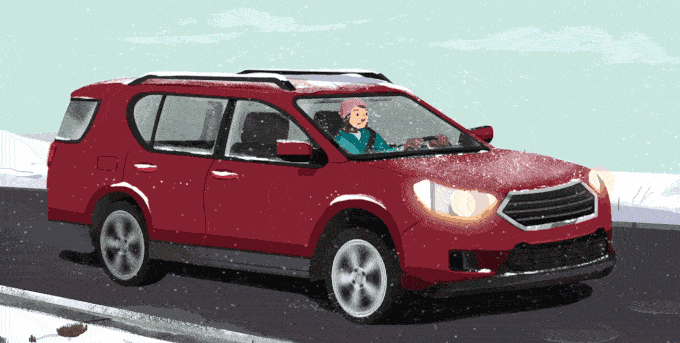Get Help Staying Safe and Sound
Find out how AAA can help keep you and your loved ones safe on the road.
Avoid slip-slidin’ away.

Nathan Hackett
You’re driving down the road when suddenly your car starts to slide on ice or snow. Other than taking it slow, do you know what to do?
Use this guide to find out how to stay safe while driving on ice—and what to do when your car begins to slide:
Most of today’s vehicles are equipped with antilock braking and electronic stability control, two technologies that help you maintain control on slick roads. Understand how these technologies can help, so you’re aware of how your car may react while driving on ice or in snowy conditions.
Antilock brakes: An antilock braking system prevents wheel lock-up by automatically regulating the brakes. It can decrease braking distances on slippery pavement, prevent skidding and provide greater control during sudden stops.
Electronic stability control: A system that provides selective wheel braking to improve vehicle handling and help drivers regain control in certain extreme circumstances. It uses components of the anti-lock braking system and is required on all passenger vehicles starting with the 2012 model year.
Stay ahead of the storm. Weather alerts are free for AAA Members.
Sign Up TodayWhen you purchased your vehicle, you might’ve chosen between front-wheel, rear-wheel, all-wheel and four-wheel drive based on the driving and weather conditions of where you live—or maybe just whichever came with the vehicle. Don’t know the difference between the four? Here’s a breakdown to help you understand how each works while driving on ice and snow:
Front-wheel drive: Front-wheel drive pulls the vehicle forward. It offers better traction out of the four, which can be especially useful in rainy or snowy conditions.
Rear-wheel drive: Rear-wheel drive pushes the vehicle forward, and it’s helpful to have in more rugged conditions where your vehicle may take some wear and tear.
All-wheel drive: All-wheel drive powers all four wheels at the same time, but these systems come in two types: full-time and part-time. Full-time powers all four wheels, while part-time mostly uses two wheels until additional traction control is needed.
Four-wheel drive: Four-wheel drive and all-wheel drive work similarly, except four-wheel drive can be more helpful in off-road terrain.
When your car starts to slide while driving on ice, it’s simply because you’re going too fast for the conditions. That’s why it’s recommended to drive at a slower, safe speed so you can avoid taking abrupt actions like slamming on brakes.
While you’re driving on ice, few things compare to that moment of panic when your tires lose traction and your vehicle starts to slide. Although you may feel helpless, you’re not. Prompt action, combined with new automotive safety technologies, can help you quickly regain control of your car.
Step 1: Decelerate, and avoid slamming on brakes. Your wheels must be able to turn freely.
Step 2: Look in the direction you want your car to go and turn your wheel in the same direction—this is more commonly referred to as “turning into the slide.”
Step 3: Straighten your steering wheel as you feel your car straightening out.
Also keep in mind how fast and far your car is sliding. If it’s a smaller slide, slightly turn your wheel. If it’s a wider slide, turn it more—but remain cautious. Lastly, always keep your eyes in the direction you want your car to go, and be prepared to respond if your car slides in the opposite direction.
Now that you know how to correct a slide, here are a few ways to avoid it altogether.
Drive slowly and steer smoothly: It may be obvious, but it’s something to be mindful of while driving in icy or snowy conditions—especially when other cars on the road might zoom past you. Keep it slow and steer smoothly so you don’t cause any abrupt movements.
Allow extra room between you and the car in front of you: If your vehicle slides, you’ll want to give yourself some space to correct it, as it’s best not to apply the brakes.
For new tires and more: Members receive a free vehicle maintenance inspection, get 10% off labor (save up to $50) and more at AAA Approved Auto Repair shops.
Find a FacilityInstall winter tires on all four wheels: If you live in an area that’s prone to frequent ice and snowstorms, installing winter tires on your vehicle may be a worthwhile investment.
Never use cruise control on a wet or slippery road: While you may want to use cruise control to maintain a slow speed, avoiding cruise control will allow you to respond instantly to a loss-of-traction situation when you lift your foot off the accelerator.
Add weight to the trunk: If you have a rear-wheel drive vehicle, put several sandbags in the trunk to add weight and improve traction while you’re driving on ice and snow.